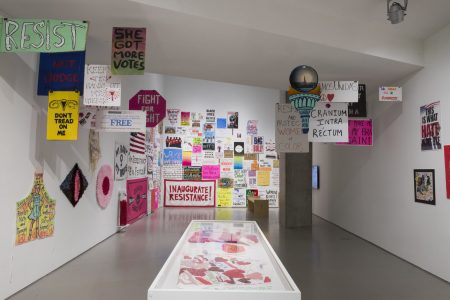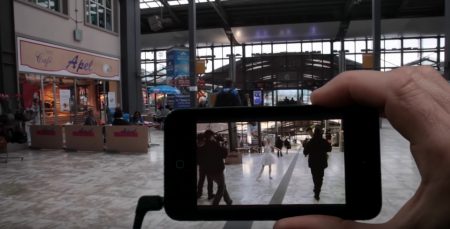During this time of the pandemic, in addition to reading, what I have been doing a lot of is walking. Every day, sometimes going two or even three times, just for the purpose of getting out of the house, getting some space to think or reflect. A change of scenery at a slow pace. An adventure that’s not going to happen on the internet.
Now that I think about it, my year started with a walk. I volunteered for the 2020 Cincinnati Women’s March, political action in the form what is sometimes referred to as “radical walking”. I taught a protest sign making workshop and made a brief audio documentary. It was thrilling to hear people say in their own articulate, intelligent voices why they marched. There were some great signs at the march too; the artist in many people came out in vibrant expression of celebration and outrage. After the Women’s March in 2017, when an estimated 7 million people worldwide took to the streets in protest of the new U.S. president, the Cincinnati-based group FemFour collected and exhibited signs from that historic event for a project called “Still They Persist”. To date, the collection has been shown in Ohio, Kentucky, New York, California, and Maryland.

There is something exciting about taking to the streets on foot and with a common purpose. Due to social distancing, in what is more like a daily promenade than a parade or protest march, lately we see lots of people walking with a common purpose: relieving the stress of COVID-19 and stay-at-home orders. Walking is a fundamental process of life, and it gets us more places than just from here to there, especially when we have no place in particular to go. It is an action that may be as cognitive, psychological, spiritual and intellectual as it is physical. As Rebecca Solnit writes in her extensive study of the subject, Wanderlust, A History of Walking, “To make walking into an investigation, a ritual, a meditation, is a special subset of walking, physiologically like and philosophically unlike the way the mail carrier brings the mail and the office worker reaches the train.”[i]
Artists have also claimed the act of walking and its outcomes as worthy of aesthetic investigation. The fascination with the city-wandering flaneur of Baudelaire evolved into the Surrealist deambulations, a use of walking to randomly selected or banal locations in order to see differently, and then the derive, or “drift” of the Situationists and their exploration of the psychogeography, or hidden, non-physical connections inherent in the urban environment. Later, artists like Richard Long drew attention to the conceptual possibilities of the rural landscape.
Much ground has been covered by male artists but walking in public has historically been different for women. Again from Solnit’s book is a quote from the diary of 19-year old poet Sylvia Plath, “Yes, my consuming desire to mingle with road crews, sailors and soldiers, barroom regulars – to be part of a scene, anonymous, listening, recording – all is spoiled by the fact that I am a girl, a female always in danger of assault and battery. My consuming interest in men and their lives is often misconstrued as a desire to seduce them, or as an invitation to intimacy. Yes, God, I want to talk to everybody I can as deeply as I can. I want to be able to sleep in an open field, to travel west, to walk freely at night.”[ii] The movement of women in public space has long had limitations both legal and cultural, spoken and unspoken. As women artists have considered walking as a critical part of their ideas, some have directly addressed this disparity while others have focused their attention on other aspects of the form. What follows is a kind of cross-section of projects that include walking rather than specific works of “walking art”.
First generation conceptual artist and analytical philosopher Adrian Piper’s work is focused on identity. In late 1972 she began a series called “The Mythic Being” where she adopted the appearance of “her seeming opposite: a third-world, working class, overtly hostile male” in response to the question she posed to herself, “What would happen if there was a being who had exactly my history, only a completely different visual appearance to the rest of society? And that’s why I dress as a man.” The series consists of newspaper advertisements as well as photography with text and video documentation of Piper as “The Mythic Being” walking the streets of New York City with mirror sunglasses, Afro wig, mustache, with cigarette dangling, repeating a sometimes mundane mantra taken from Piper’s diaries. In the video, “The Mythic Being” prepares his appearance and rehearses, then walks the streets reciting his lines. Passersby are both excited and perplexed, not quite sure who or what they are seeing.
Piper’s work is deeply layered, starting with the self as subject and its transformation into an object of examination. Her performance works such as “The Mythic Being” are experiments in self-objectification and existence in the public realm, toying with conventional expectations of society, institutional structures, stereotypes, and confronting sexism and racism.
When walking through city streets, one might sometimes feel vulnerable, but in the best of circumstances feels secure in their own personal space, anonymity and privacy in public. Sophie Calle’s work dispenses with the unwritten social contract of privacy in public and engages in the act of stalking. In her photography and text based practice of surveillance, she explores what one can learn about strangers by following them, and expresses the mystery and desire contained in the space that separates the observer from the observed.
In 1979 she began following people on the street. Of this mode of working, she has said at that time she didn’t have any friends and didn’t know what to do. Following someone meant all decisions are made for you, where to go, what restaurant to eat in, etc. Later she began to use this method for making her art. In her 1981 project “Suite Venitienne”, she moved to Venice to trail someone she met at a party after she overheard him saying he was going there. After tracking him down by calling almost 100 hotels, without his knowledge she followed him obsessively and recorded her attempts to catch a glimpse of him. In this early work, Calle exposes the illusion of privacy as much as she flips the script on street harassment.
A 2007 project by Eve Mosher called High Water Line took viewers on a walk into the future of a changing climate. Armed with topographic maps and NASA data about a predicted rise of 10 feet in sea level during increasingly frequent flooding in New York City, Mosher traced a 70 mile blue chalk line around the Manhattan and Brooklyn coastline using a Heavy Hitter (a ball field chalking machine) that showed where neighborhoods would be underwater. During her walk, she spoke to people in the neighborhoods she visited and handed out flyers describing her project as a way to open up conversations about actions to reduce the effects of climate change. When Hurricane Sandy devastated parts of New York in 2012, she saw the results of those predictions, some of which were extremely accurate. She wrote on her website “I never wanted this to be a reality. Five years ago I couldn’t have even imagined it”. But photos of the project compared with photos of areas flooded by the hurricane are eerily prophetic.
Janet Cardiff is known for her audio walks and sound installations. In 2012, she collaborated with George Bures Miller on a 26-minute walk called “Alter Bahnhoff Video Walk” for the Documenta Thirteen in Kassel Germany. In this piece viewers borrow an ipod with headphones that directs viewers on an audio walk with video through the train station at Kassel. The video shows the space at the time when the artist made the piece, full of musicians playing, a ballerina dancing, and a dog barking and jumping in the station. As the viewer walks, their present experience is overlapped with both the sight and sound of the artist at the time of the making of the work, along with the artist’s narration. To confuse time and space even more, the artist speaking (Cardiff) tells you at one point that is it she you see in the video getting onto the train. Reality and fiction begin to blend in what has been referred to as “physical cinema”.
In 1988, performance artist duo Marina Abramovic and Ulay (Frank Uwe Laysiepen) conducted an epic trek at the Great Wall of China. Initially the idea was to start at opposite ends and meet in the middle to marry: two lovers, drawn to each other like magnets, walking in solitude for 90 days to finally be reunited. The artists chose the Great Wall for this work because it was one of the only human-built landmarks that could be seen from space at the time. After the eight years it took to plan and raise the funding, the couple’s relationship was dissolving, so they decided to use the work to mark the end of their relationship instead.
The durational works of Abramovic and Ulay, and of Abramovic as a solo artist, push the boundaries of human behavior and capacity. For this work, each of them walked almost 1800 miles mostly through remote rural China. Contrary to what is often seen of the Great Wall at tourist destinations, much of the original path has degraded into crumbling boulders. Abramovic says of her experience, “it was painful, it was hardship, but it made me merge with the landscape”. The work is documented in a film and photographs, as well as in numerous interviews with the artists. Ulay died on March 2nd, 2020.
The field of walking work, by artists of all gender identifications, is much larger and more distinct than I imagined when I set out to write this. Websites such as walkingart.interartive.org and walkingartistsnetwork.org document and promote historic and contemporary work, critical theory, seminars and other scholarship, including a number of fairly recent publications and exhibitions.
–Susan Byrnes
[i] Rebecca Solnit, Wanderlust, A History of Walking (Penguin Books, 2000), 3
[ii] Ibid, 233




